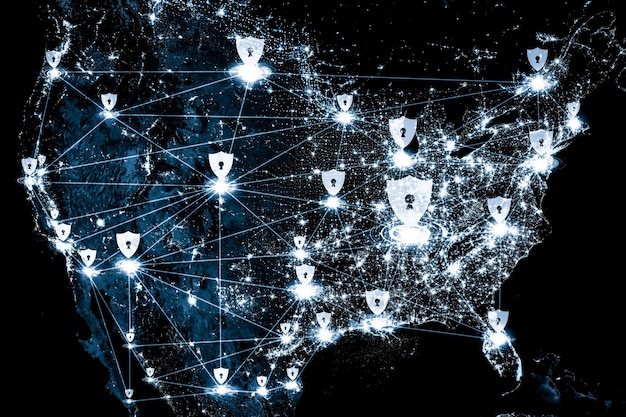New Cybersecurity Regulations Impacting US Businesses in 2025

Anúncios
Breaking: New Cybersecurity Regulations Impacting All US Businesses Starting January 2025 will require significant adjustments to data protection strategies, compliance protocols, and overall cybersecurity infrastructure for companies operating within the United States.
Anúncios
The landscape of cybersecurity is constantly evolving, and US businesses must remain vigilant to protect their valuable data. Breaking: New Cybersecurity Regulations Impacting All US Businesses Starting January 2025 are set to reshape the way companies approach data security, demanding proactive measures and adherence to stricter guidelines.
Understanding the Impending Cybersecurity Regulations
The upcoming cybersecurity regulations represent a significant shift in how US businesses are expected to safeguard sensitive data. Grasping the scope and implications of these changes is crucial for compliance and ensuring business continuity.
These regulations are not merely suggestions; they are legally binding requirements that carry potential penalties for non-compliance. Understanding the nuances of the law is the first step toward protecting your business from both cyber threats and legal repercussions.
Anúncios
Key Provisions of the New Regulations
Several key provisions form the core of these new cybersecurity regulations. These provisions address various aspects of data protection, incident response, and compliance reporting.
- Data Encryption Standards: Mandates the use of robust encryption methods for data at rest and in transit.
- Incident Reporting Requirements: Establishes strict timelines for reporting data breaches and cybersecurity incidents.
- Regular Security Audits: Requires businesses to conduct periodic security audits to identify vulnerabilities and assess compliance.
- Employee Training Programs: Emphasizes the importance of cybersecurity awareness training for all employees.

Failing to comply with these provisions can result in steep fines, legal action, and reputational damage. Therefore, businesses must proactively prepare and implement the necessary measures to meet these requirements.
In conclusion, the impending cybersecurity regulations bring forth a new era of accountability and proactive data protection. Businesses must prioritize understanding and adhering to these provisions to safeguard their operations and maintain customer trust.
Who Is Affected by These Regulations?
The reach of these new cybersecurity regulations extends to a broad spectrum of US businesses. Determining whether your organization falls under these requirements is essential for initiating the necessary compliance measures.
These regulations are not limited to specific industries or company sizes. Whether you’re a small startup or a large corporation, if you handle sensitive data, these rules likely apply to you.
Industry-Specific Considerations
While the core regulations apply broadly, certain industries may face additional requirements tailored to their specific data handling practices. Healthcare, finance, and critical infrastructure are examples of sectors with unique compliance obligations.
For instance, healthcare providers must adhere to HIPAA regulations, which intersect with these new cybersecurity rules to create a comprehensive data protection framework. Similarly, financial institutions must comply with regulations like GLBA, which mandate specific cybersecurity measures.
Analyzing Your Business’s Data Footprint
Assess the types and volume of data your business collects, processes, and stores. This analysis will help determine your risk exposure and the level of compliance required under the new regulations. Businesses handling personally identifiable information (PII), financial data, or healthcare records will face stricter scrutiny.
In summary, the scope of these cybersecurity regulations is extensive, impacting a wide range of US businesses. Understanding whether your organization falls within the regulatory framework is a critical first step toward compliance.
Preparing Your Business for Compliance
Preparing for these new cybersecurity regulations requires a strategic and proactive approach. Businesses should begin by assessing their current cybersecurity posture and identifying areas for improvement.
This preparation process involves a series of steps, including conducting risk assessments, implementing security controls, and developing incident response plans. A well-defined plan is essential for achieving and maintaining compliance.
Conducting a Thorough Risk Assessment
A comprehensive risk assessment is the foundation of any effective cybersecurity strategy. This assessment should identify potential threats, vulnerabilities, and the potential impact on your business.
The risk assessment should consider both internal and external threats. Internal threats may include employee negligence, insider threats, or inadequate security practices. External threats may include malware attacks, phishing scams, and ransomware.
Implementing Robust Security Controls
Security controls are the safeguards you put in place to protect your data from threats. These controls may include technical measures like firewalls, intrusion detection systems, and data encryption, as well as administrative measures like security policies and employee training.
- Firewalls and Intrusion Detection Systems: Monitor network traffic for malicious activity and prevent unauthorized access.
- Data Encryption: Protects sensitive data by converting it into an unreadable format.
- Access Controls: Limits access to sensitive data based on the principle of least privilege.
Effectively preparing your business for compliance involves a multifaceted approach. By conducting thorough risk assessments, implementing robust security controls, and prioritizing employee training, you can create a resilient defense against cyber threats and ensure adherence to the new regulations.
The Role of Employee Training and Awareness
Employee training and awareness play a vital role in strengthening an organization’s cybersecurity posture. Educating employees on potential threats and best practices can significantly reduce the risk of human error and insider threats.
Cybersecurity is no longer just an IT issue; it’s a shared responsibility that requires the active participation of every employee. A well-trained workforce is a critical asset in defending against increasingly sophisticated cyberattacks.

Developing Effective Training Programs
Effective training programs should cover a range of topics, including phishing awareness, password security, data handling procedures, and incident reporting protocols. The training should be engaging, relevant, and tailored to the specific needs of your organization.
Regular training updates are essential to keep employees informed about the latest threats and security best practices. Cybersecurity is a dynamic field, and training programs must evolve to address emerging risks.
Simulating Phishing Attacks
Simulated phishing attacks are a valuable tool for assessing employee awareness and identifying areas for improvement. These simulations can help employees recognize and avoid real phishing attempts.
By creating a culture of security awareness, organizations can empower employees to become a first line of defense against cyber threats. This proactive approach is essential for mitigating risk and protecting sensitive data.
In conclusion, employee training and awareness are indispensable components of a robust cybersecurity strategy. By investing in comprehensive training programs, organizations can enhance their overall security posture and mitigate the risk of human error.
Navigating the Legal Landscape and Potential Penalties
Understanding the legal landscape surrounding cybersecurity regulations is crucial for avoiding potential penalties and ensuring compliance. Businesses must be aware of their legal obligations and the potential consequences of non-compliance.
Non-compliance with cybersecurity regulations can result in significant financial penalties, legal action, and reputational damage. Staying informed about the legal requirements is essential for protecting your business.
Potential Fines and Legal Actions
Fines for non-compliance can vary depending on the severity of the violation and the specific regulations involved. Some regulations impose per-record fines, while others impose fixed penalties for each violation.
In addition to fines, businesses may face legal action from government agencies, customers, or other stakeholders. Lawsuits related to data breaches can be costly and time-consuming.
Building a Culture of Compliance
Creating a culture of compliance is essential for ensuring long-term adherence to cybersecurity regulations. This involves establishing clear policies, providing regular training, and monitoring compliance efforts.
In summary, navigating the legal landscape and understanding potential penalties are critical aspects of cybersecurity compliance. By staying informed, building a culture of compliance, and seeking legal counsel when necessary, businesses can mitigate risk and protect their operations.
The Future of Cybersecurity Regulations
The landscape of cybersecurity regulations is constantly evolving in response to emerging threats and technological advancements. Staying ahead of these changes is essential for maintaining compliance and protecting your business.
As technology continues to evolve, cybersecurity regulations will likely become more stringent and comprehensive. Businesses must be prepared to adapt to these changes and invest in ongoing compliance efforts.
Emerging Trends in Cybersecurity Regulation
Several emerging trends are shaping the future of cybersecurity regulation, including increased emphasis on data privacy, proactive security measures, and international cooperation.
- Data Privacy Regulations: Laws like GDPR and CCPA are influencing cybersecurity regulations in the US and around the world..
- Proactive Security Measures: Regulations are increasingly emphasizing proactive security measures, such as threat hunting, vulnerability assessments, and incident response planning.
- International Cooperation: Governments are working together to combat cybercrime and harmonize cybersecurity regulations..
By staying informed about these trends, businesses can anticipate future regulatory requirements and proactively adapt their cybersecurity strategies. This proactive approach is essential for maintaining a competitive edge and protecting against emerging threats.
In conclusion, the future of cybersecurity regulations is characterized by continuous evolution and increasing complexity. Businesses must embrace a proactive approach to compliance and stay informed about emerging trends to protect their operations and maintain customer trust.
| Key Point | Brief Description |
|---|---|
| 🔒 New Regulations Jan 2025 | Significant changes to data protection for US businesses. |
| 💼 Who’s Affected | Broad impact across industries; assess data footprint. |
| 🛡️ Preparing for Compliance | Risk assessments, security controls, and incident response are key. |
| 👨🏫 Employee Training | Vital for reducing human error; conduct phishing simulations. |
Frequently Asked Questions (FAQ)
The regulations emphasize data encryption, incident reporting timelines, regular security audits, and comprehensive employee training programs. Compliance will require significant adaptations to current protocols.
The frequency of security audits will depend on the specific regulations and your industry. However, it is generally recommended to conduct audits at least annually, or more frequently if significant changes occur.
The regulations stipulate the use of robust encryption methods for data, both in transit and at rest. Consult with cybersecurity experts to determine the most appropriate encryption standards for your organization.
Non-compliance can result in significant financial penalties, legal action from government agencies or customers, and damage to your company’s reputation. It’s crucial to ensure adherence to all new stipulations.
Stay informed about emerging threats and vulnerabilities by subscribing to cybersecurity news sources, participating in industry forums, and partnering with cybersecurity experts. Continual education is vital for sustained security.
Conclusion
As January 2025 approaches, US businesses must prioritize understanding and implementing these new cybersecurity regulations. By taking proactive steps to assess risks, implement security controls, and train employees, companies can navigate the evolving regulatory landscape and protect their valuable data assets.





